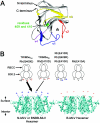Two surface-exposed elements of the B30.2/SPRY domain as potency determinants of N-tropic murine leukemia virus restriction by human TRIM5alpha
- PMID: 16699044
- PMCID: PMC1472168
- DOI: 10.1128/JVI.00219-06
Two surface-exposed elements of the B30.2/SPRY domain as potency determinants of N-tropic murine leukemia virus restriction by human TRIM5alpha
Abstract
Human TRIM5alpha (TRIM5alpha(hu)) potently restricts N-tropic (N-MLV), but not B-tropic, murine leukemia virus in a manner dependent upon residue 110 of the viral capsid. Rhesus monkey TRIM5alpha (TRIM5alpha(rh)) inhibits N-MLV only weakly. The study of human-monkey TRIM5alpha chimerae revealed that both the v1 and v3 variable regions of the B30.2/SPRY domain contain potency determinants for N-MLV restriction. These variable regions are predicted to be surface-exposed elements on one face of the B30.2 domain. Acidic residues in v3 complement basic residue 110 of the N-MLV capsid. The results support recognition of the retroviral capsid by the TRIM5alpha B30.2 domain.
Figures




Similar articles
-
Species-specific variation in the B30.2(SPRY) domain of TRIM5alpha determines the potency of human immunodeficiency virus restriction.J Virol. 2005 Mar;79(5):3139-45. doi: 10.1128/JVI.79.5.3139-3145.2005. J Virol. 2005. PMID: 15709033 Free PMC article.
-
The human TRIM5alpha restriction factor mediates accelerated uncoating of the N-tropic murine leukemia virus capsid.J Virol. 2007 Mar;81(5):2138-48. doi: 10.1128/JVI.02318-06. Epub 2006 Nov 29. J Virol. 2007. PMID: 17135314 Free PMC article.
-
A human TRIM5alpha B30.2/SPRY domain mutant gains the ability to restrict and prematurely uncoat B-tropic murine leukemia virus.Virology. 2008 Sep 1;378(2):233-42. doi: 10.1016/j.virol.2008.05.008. Epub 2008 Jun 30. Virology. 2008. PMID: 18586294 Free PMC article.
-
Recent insights into the mechanism and consequences of TRIM5α retroviral restriction.AIDS Res Hum Retroviruses. 2011 Mar;27(3):231-8. doi: 10.1089/AID.2010.0367. AIDS Res Hum Retroviruses. 2011. PMID: 21247355 Free PMC article. Review.
-
TRIM5alpha.Curr Top Microbiol Immunol. 2009;339:47-66. doi: 10.1007/978-3-642-02175-6_3. Curr Top Microbiol Immunol. 2009. PMID: 20012523 Review.
Cited by
-
A single amino acid of human immunodeficiency virus type 2 capsid protein affects conformation of two external loops and viral sensitivity to TRIM5α.PLoS One. 2011;6(7):e22779. doi: 10.1371/journal.pone.0022779. Epub 2011 Jul 28. PLoS One. 2011. PMID: 21829511 Free PMC article.
-
Virus-specific effects of TRIM5α(rh) RING domain functions on restriction of retroviruses.J Virol. 2013 Jul;87(13):7234-45. doi: 10.1128/JVI.00620-13. Epub 2013 May 1. J Virol. 2013. PMID: 23637418 Free PMC article.
-
Role of Human TRIM5α in Intrinsic Immunity.Front Microbiol. 2012 Mar 15;3:97. doi: 10.3389/fmicb.2012.00097. eCollection 2012. Front Microbiol. 2012. PMID: 22435067 Free PMC article.
-
Structural basis for PRYSPRY-mediated tripartite motif (TRIM) protein function.Proc Natl Acad Sci U S A. 2007 Apr 10;104(15):6200-5. doi: 10.1073/pnas.0609174104. Epub 2007 Mar 30. Proc Natl Acad Sci U S A. 2007. PMID: 17400754 Free PMC article.
-
Characterization of a core fragment of the rhesus monkey TRIM5α protein.BMC Biochem. 2011 Jan 4;12:1. doi: 10.1186/1471-2091-12-1. BMC Biochem. 2011. PMID: 21205312 Free PMC article.
References
-
- Bieniasz, P. D. 2003. Restriction factors: a defense against retroviral infection. Trends Microbiol. 11:286-291. - PubMed
-
- Goff, S. P. 2004. Genetic control of retrovirus susceptibility in mammalian cells. Annu. Rev. Genet. 38:61-85. - PubMed
-
- Grutter, C., C. Briand, G. Capitani, P. R. Mittl, S. Papin, J. Tschopp, and M. G. Grutter. 2006. Structure of the PRYSPRY-domain: implications for autoinflammatory diseases. FEBS Lett. 580:99-106. - PubMed
Publication types
MeSH terms
Substances
Grants and funding
LinkOut - more resources
Full Text Sources

